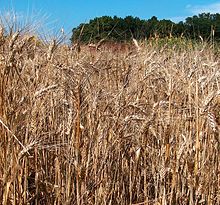
Back Durum Afrikaans قمح قاسي Arabic قمح صلب ARZ Твърда пшеница Bulgarian Blat dur Catalan Triticum durum CEB Triticum turgidum Corsican Semolina Czech Gwenith barfog Welsh Durumhvede Danish
| Durum | |
|---|---|

| |
| Durum wheat | |
| Scientific classification | |
| Kingdom: | Plantae |
| Clade: | Tracheophytes |
| Clade: | Angiosperms |
| Clade: | Monocots |
| Clade: | Commelinids |
| Order: | Poales |
| Family: | Poaceae |
| Subfamily: | Pooideae |
| Genus: | Triticum |
| Species: | T. durum
|
| Binomial name | |
| Triticum durum | |
| Synonyms[1] | |
|
List
| |
Durum wheat[2] (/ˈdjʊərəm/), also called pasta wheat[3] or macaroni wheat (Triticum durum or Triticum turgidum subsp. durum),[4] is a tetraploid species of wheat.[5] It is the second most cultivated species of wheat after common wheat, although it represents only 5% to 8% of global wheat production.[6] It was developed by artificial selection of the domesticated emmer wheat strains formerly grown in Central Europe and the Near East around 7000 BC, which developed a naked, free-threshing form.[7] Like emmer, durum wheat is awned (with bristles). It is the predominant wheat that grows in the Middle East.
Durum in Latin means "hard", and the species is the hardest of all wheats. This refers to the resistance of the grain to milling, in particular of the starchy endosperm, causing dough made from its flour to be weak or "soft". This makes durum favorable for semolina and pasta and less practical for flour, which requires more work than with hexaploid wheats like common bread wheats. Despite its high protein content, durum is not a strong wheat in the sense of giving strength to dough through the formation of a gluten network. Durum contains 27% extractable wet gluten, about 3% higher than common wheat (T. aestivum L.).[8]
- ^ "The Plant List: A Working List of All Plant Species". Retrieved 28 August 2014.
- ^ USDA, NRCS (n.d.). "Triticum durum". The PLANTS Database (plants.usda.gov). Greensboro, North Carolina: National Plant Data Team. Retrieved 3 February 2016.
- ^ BSBI List 2007 (xls). Botanical Society of Britain and Ireland. Archived from the original (xls) on 2015-06-26. Retrieved 2014-10-17.
- ^ "Triticum durum". Germplasm Resources Information Network. Agricultural Research Service, United States Department of Agriculture. Retrieved 11 December 2017.
- ^ "Wheat". Archived from the original on 2014-03-30.
- ^ "Global durum wheat use trending upward". world-grain.com. Retrieved 21 March 2018.
- ^ "Triticum (genus)". Biodiversity explorer. Archived from the original on 2008-10-10.
- ^ Cite error: The named reference
zilicwas invoked but never defined (see the help page).
© MMXXIII Rich X Search. We shall prevail. All rights reserved. Rich X Search